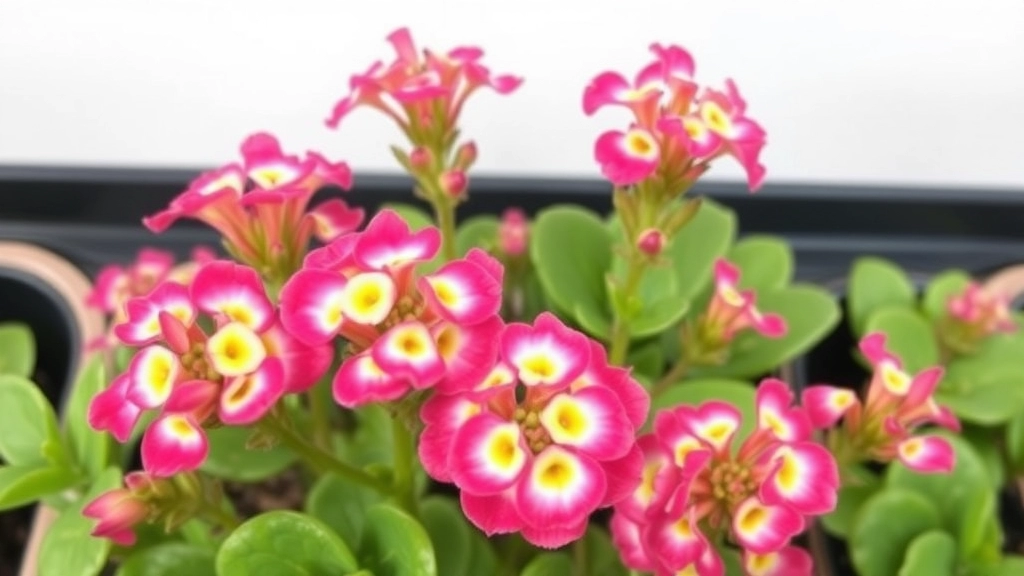Flowering Kalanchoe
Kalanchoe blossfeldiana
20-30cm tall, Kalanchoe blossfeldiana, is a stunning addition to any indoor or outdoor garden. This vibrant plant is known for its bright, colourful blooms and manageable size, making it perfect for small spaces. To ensure your Kalanchoe thrives, it’s crucial to understand its specific care needs, from soil type to watering habits.
Care Needs
Getting the right soil mix is the first step. Kalanchoe blossfeldiana prefers well-draining soil to prevent root rot. Watering should be moderate; too much can lead to problems, while too little can stunt growth. Light is equally important—these plants flourish in bright, indirect sunlight. By meeting these basic requirements, your Kalanchoe will reward you with beautiful blooms.
Best Soil Types for Kalanchoe Blossfeldiana
As a plant enthusiast, you might be wondering, “What is the best soil for my Kalanchoe Blossfeldiana?”
Choosing the right soil is crucial for the health and growth of your Kalanchoe.
Ideal Soil Composition
Kalanchoe Blossfeldiana thrives in well-draining soil that mimics its natural habitat. Here are some soil types to consider:
- Cactus Mix: Specifically designed for succulent plants, this mix provides excellent drainage.
- Potting Soil with Perlite: Regular potting soil can work, but adding perlite increases aeration and drainage.
- Homemade Mix: Combine equal parts of potting soil, sand, and perlite for a balanced option.
Key Features of the Soil
When selecting soil, look for these characteristics:
- Good Drainage: Prevents water from pooling, reducing the risk of root rot.
- pH Level: A slightly acidic to neutral pH (around 6.0 to 7.0) is ideal for Kalanchoe.
- Nutrient-Rich: While Kalanchoe doesn’t require overly rich soil, a bit of organic matter can support growth.
Tips for Soil Maintenance
- Repotting: Consider repotting every couple of years to refresh nutrients and ensure good drainage. For more detailed guidance, check out our complete care guide for Kalanchoe Blossfeldiana.
- Avoid Heavy Soils: Steer clear of clay-heavy soils that retain too much moisture. If you’re looking for more tips on optimal growth, visit our page on optimal care for Kalanchoe Blossfeldiana.
How to Water Kalanchoe for Optimal Growth
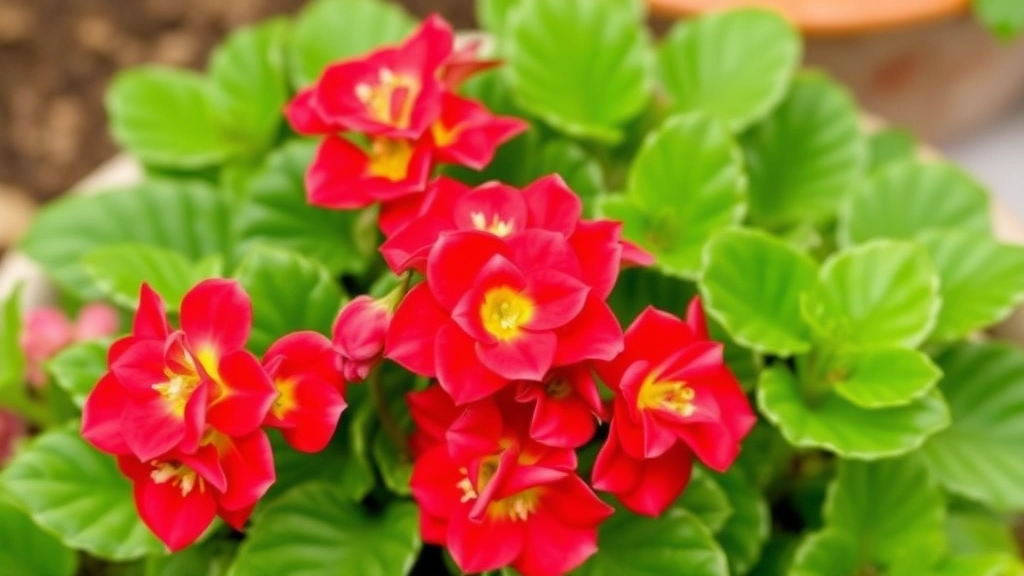
So, you’ve got your Kalanchoe Blossfeldiana all set up, and now you’re probably wondering, “How much water does this beauty really need?”
Watering Woes
Watering can be a bit tricky, especially if you’re new to caring for succulents. Too much water can lead to root rot, while too little can make your plant droop. Here’s how to strike that perfect balance:
- Check the Soil: Before you reach for the watering can, stick your finger about an inch into the soil. If it feels dry, it’s time to water. If it’s still moist, hold off for a bit.
- Water Deeply: When you do water, give it a good soak. Ensure water drains out of the bottom of the pot. This ensures that the roots get enough moisture without sitting in water.
- Frequency: Generally, you’ll want to water every 2-3 weeks. However, this can vary based on your climate and the season. In warmer months, you might need to water more often.
- Use Room Temperature Water: Cold water can shock the roots. Stick to room temperature for a happy Kalanchoe.
- Avoid Watering the Leaves: Try not to get the leaves wet. This can cause them to rot or develop fungal issues.
Watering your Kalanchoe properly is key to its vibrant growth and blooming.
Light Requirements for Healthy Flowering
Are your Kalanchoe Blossfeldiana struggling to bloom? One of the most crucial factors for vibrant flowers is proper lighting.
Understanding Light Needs
Kalanchoe thrives in bright, indirect sunlight. Here’s how to ensure your plant gets the right amount:
- Direct Sunlight: A few hours of morning sunlight is beneficial, but avoid harsh afternoon rays, which can scorch the leaves.
- Indirect Light: If you can, place your Kalanchoe near a window where it can soak up bright, filtered light.
- Artificial Light: If natural light is limited, consider using grow lights. Position them about 12-18 inches above the plant for optimal growth.
Signs of Insufficient Light
Keep an eye out for these signs indicating your Kalanchoe may not be getting enough light:
- Leggy Growth: Stems that reach for the light can indicate your plant is stretching due to low light.
- Faded Leaves: A loss of vibrant colour can suggest your plant needs more exposure.
Adjusting Light Conditions
If you notice these signs, here’s what you can do:
- Relocate: Move your plant closer to a light source.
- Rotate: Regularly rotate your Kalanchoe to ensure all sides receive equal light.
- Supplement: Use grow lights during darker months to maintain consistent light levels.
For more detailed tips on ensuring optimal growth, check out our Optimal Care for Kalanchoe Blossfeldiana Growth guide. Additionally, if you’re dealing with leggy growth due to insufficient light, our article on Fixing Etiolated Kalanchoe Blossfeldiana offers valuable insights.
Temperature and Humidity Conditions for Kalanchoe Blossfeldiana
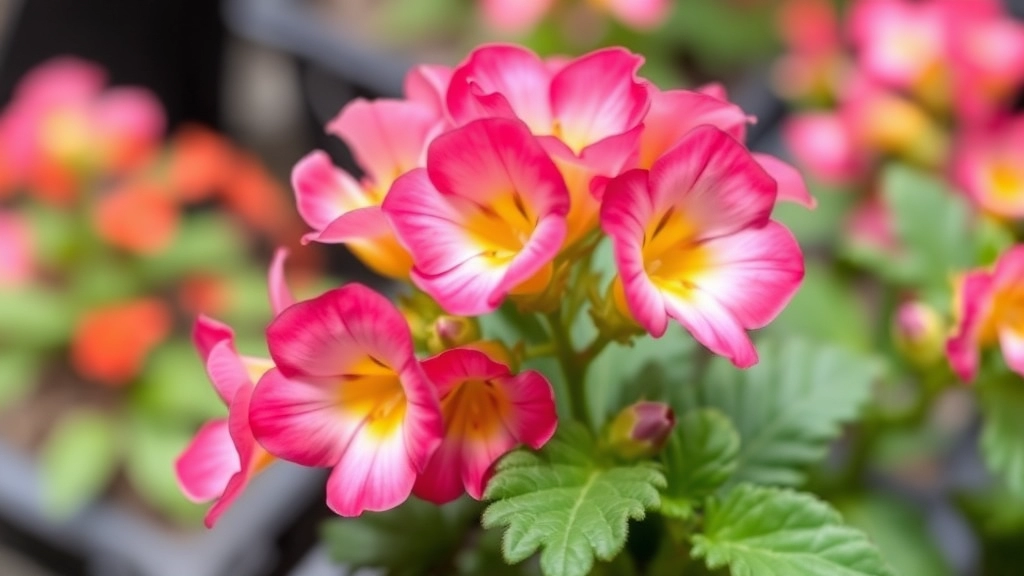
Are you struggling to keep your Kalanchoe Blossfeldiana thriving? One of the most crucial factors is understanding the right temperature and humidity conditions.
Ideal Temperature Range
Kalanchoe Blossfeldiana prefers a warm environment. The ideal temperature range is:
- Daytime: 20°C to 25°C (68°F to 77°F)
- Nighttime: 15°C to 18°C (59°F to 65°F)
These temperatures encourage healthy growth and vibrant blooms.
Humidity Levels
Humidity plays a significant role in the health of your Kalanchoe. Here’s what you need to know:
- Optimal Humidity: 40% to 60%
- Low Humidity: If the air is too dry, consider misting the plant occasionally or using a pebble tray with water to boost moisture levels.
Tips for Maintaining Conditions
- Avoid Drafts: Keep your plant away from cold drafts or direct heat sources like radiators.
- Temperature Fluctuations: Sudden changes can stress the plant, so maintain a consistent environment.
Signs of Stress
If your Kalanchoe is not happy with its temperature or humidity, you may see:
- Leaf Drooping: A sign of too much heat or low humidity.
- Wilting Flowers: Indicates that the plant is struggling with its environment.
Fertilizing Your Kalanchoe: When and How
Are you wondering when to fertilize your Kalanchoe Blossfeldiana for the best results?
Fertilizing is crucial for promoting vibrant blooms and healthy foliage.
When to Fertilize Your Kalanchoe
- Growing Season: The ideal time to fertilize is during the active growing season, which typically spans from spring to early autumn.
- Frequency: Aim to fertilize every 4-6 weeks. This ensures your plant receives a consistent supply of nutrients.
- Rest Period: In winter, reduce or stop fertilization as the plant enters a dormant phase.
How to Fertilize Your Kalanchoe
- Choose the Right Fertilizer: Use a balanced, water-soluble fertilizer with an N-P-K ratio of 10-10-10 or similar.
- Dilution: Always dilute the fertilizer to half the recommended strength to avoid burning the roots.
- Application:
- Water your Kalanchoe first to prevent root shock.
- Apply the diluted fertilizer around the base of the plant, avoiding direct contact with the leaves.
Signs Your Kalanchoe Needs Fertilizing
- Pale Leaves: If the leaves appear yellow or pale, it may indicate a nutrient deficiency. For more details on leaf care, check out our Kalanchoe Blossfeldiana Leaf Care Tips and Troubleshooting.
- Reduced Flowering: Fewer blooms can suggest that the plant isn’t getting enough nutrients. Learn more about maintaining vibrant blooms in our Kalanchoe Blossfeldiana Flowering Period Care Tips.
How to Encourage Re-Blooming in Kalanchoe Blossfeldiana
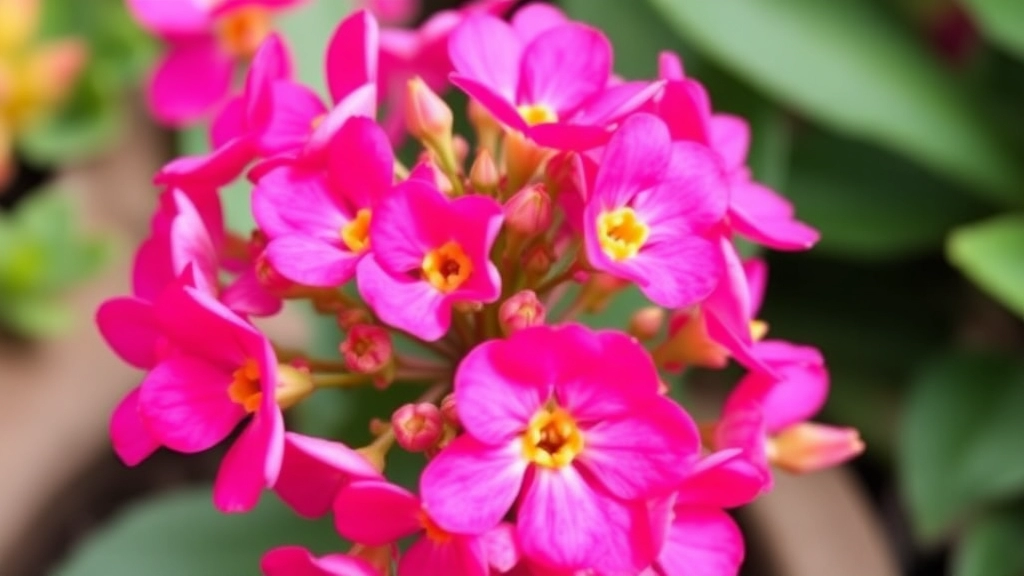
Ever found yourself staring at your Kalanchoe Blossfeldiana, wondering why it’s not blooming again? You’re not alone! Many plant lovers face this issue, and it can be frustrating. But don’t worry—there are simple ways to coax those lovely flowers back into action.
Light is Key
First off, let’s talk about light. Your Kalanchoe needs bright, indirect sunlight to thrive. If it’s been sitting in a dim corner, it’s time to move it to a sunnier spot.
- Aim for 6 hours of indirect sunlight daily.
- Avoid harsh afternoon sun to prevent leaf scorch.
Pruning for Encouragement
Next, consider a little pruning. Snipping off spent blooms and leggy stems can help redirect the plant’s energy.
- Use clean, sharp scissors to avoid any disease transfer.
- Cut just above a leaf node to encourage new growth.
Watering Wisely
Now, let’s chat about watering. Overwatering can stress your plant, leading to fewer blooms.
- Water only when the top inch of soil is dry.
- Ensure good drainage to keep roots happy.
Fertilizing for Flower Power
Fertilizing is another crucial step. A balanced, water-soluble fertilizer can work wonders.
- Feed every 4-6 weeks during the growing season.
- Look for a fertilizer high in phosphorus to boost blooms.
Temperature and Day Length
Finally, keep an eye on temperature and day length. Kalanchoe blossoms love a bit of a chill.
- Aim for 15-20°C (60-68°F) during the day.
- Shorter days (around 12-14 hours of light) can trigger blooming.
Common Pests and How to Deal with Them
As you nurture your Kalanchoe Blossfeldiana, you may encounter some unwelcome guests.
Pruning and Deadheading Techniques for Fuller Growth
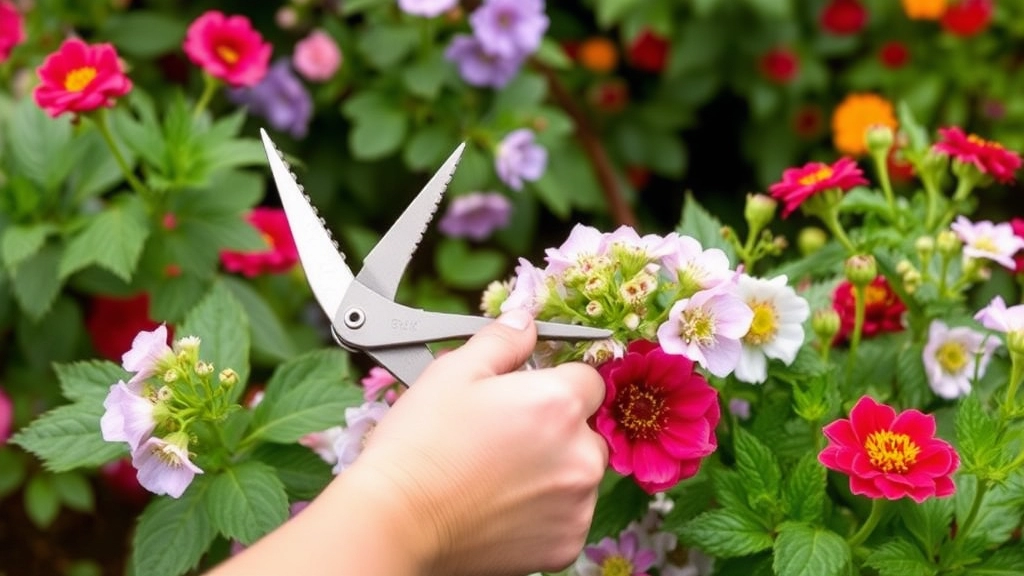
So, you’ve got your Kalanchoe Blossfeldiana blooming beautifully, but how do you keep it looking its best?
Pruning and deadheading are essential techniques that can really boost your plant’s health and encourage fuller growth.
Why Prune and Deadhead?
- Promotes New Growth: Cutting back old stems encourages fresh shoots.
- Encourages Blooms: Removing spent flowers helps the plant focus energy on producing new blooms.
- Prevents Disease: Regular pruning can help you spot any potential issues early.
When to Prune
- After Flowering: Once your Kalanchoe has finished its blooming cycle, it’s the perfect time to trim it back.
- Regular Maintenance: Keep an eye on your plant. If you notice any dead or yellowing leaves, snip them off.
How to Prune
- Use Clean Tools: Always start with sterilized scissors or pruning shears to avoid spreading disease.
- Identify Old Stems: Look for stems that are leggy or have finished flowering.
- Cut Above a Leaf Node: This encourages new growth from the cut point.
- Trim Sparingly: You don’t need to go overboard. A little trim can go a long way.
Deadheading Made Easy
Deadheading is simply removing spent flowers to keep your Kalanchoe looking fresh.
- Check Regularly: Look for flowers that have wilted or turned brown.
- Pinch Off Gently: Use your fingers or scissors to remove the spent bloom, taking care not to damage surrounding buds.
Tips for Fuller Growth
- Don’t Overdo It: Pruning too much can stress the plant.
- Feed After Pruning: A little fertiliser post-pruning can give your Kalanchoe a boost.
- Observe Growth Patterns: Pay attention to how your plant responds to pruning and adjust your technique accordingly.
How to Propagate Kalanchoe Blossfeldiana Using Cuttings
Are you wondering how to expand your collection of Kalanchoe Blossfeldiana without spending a fortune? Propagation through cuttings is a straightforward and rewarding method to grow new plants.
Why Choose Cuttings?
Using cuttings allows you to create clones of your existing plants. This means you can maintain the same traits, such as flower colour and growth habits.
Steps for Successful Propagation
- Select Healthy Cuttings
– Look for stems that are firm and healthy.
– Choose cuttings that are around 4-6 inches long.
– Ensure there are a few leaves on the stem. - Prepare the Cuttings
– Use clean, sharp scissors or pruning shears to make a clean cut.
– Remove the lower leaves to prevent rot when placed in soil.
– Allow the cuttings to dry for a few hours to form a callus over the cut end. - Choose the Right Soil
– Use a well-draining potting mix, ideally one designed for succulents.
– You can create your own mix by combining standard potting soil with sand or perlite. For more detailed information, check out our guide on the best soil for Kalanchoe Blossfeldiana care tips. - Plant the Cuttings
– Insert the callused end of the cutting into the soil, burying it about an inch deep.
– Space multiple cuttings at least a few inches apart to allow for growth. - Water Sparingly
– After planting, lightly water the soil to settle it around the cuttings.
– Avoid overwatering; let the soil dry out between waterings. - Provide Optimal Conditions
– Place the cuttings in a warm, bright location but out of direct sunlight.
– Maintain a temperature between 20-25°C (68-77°F) for best results. For more on ideal growing conditions, see our article on the optimal care for Kalanchoe Blossfeldiana growth. - Monitor Growth
– After a few weeks, check for new growth, which indicates successful rooting.
– Once established, you can treat them like mature Kalanchoe plants.
Preventing Root Rot and Other Common Diseases
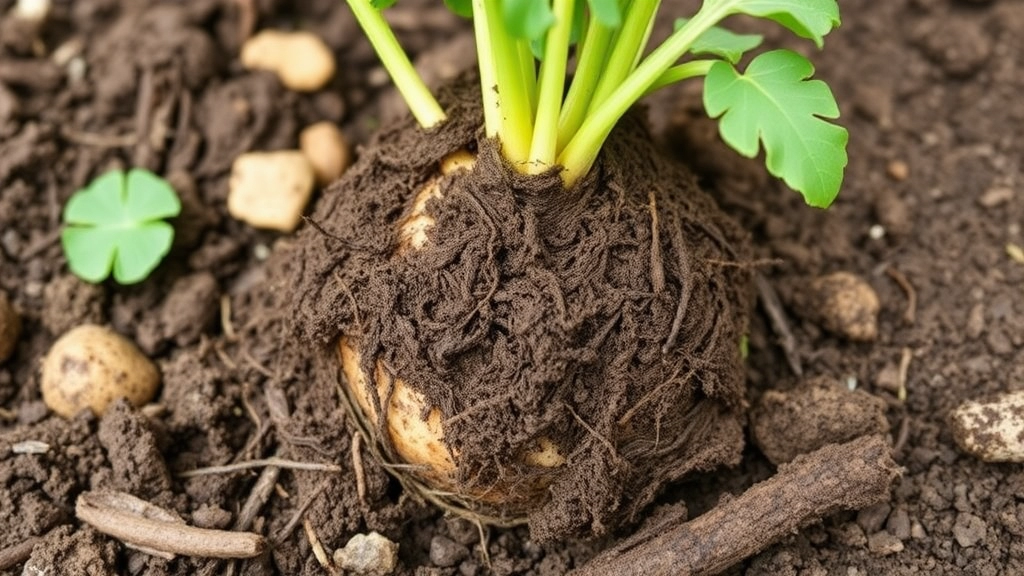
Have you ever noticed your Kalanchoe looking a bit sad, or worse, drooping at the leaves?
Root rot is a sneaky villain in the world of plant care, and it can strike when you least expect it.
Let’s dive into how to prevent root rot and tackle other common diseases that can affect your Kalanchoe Blossfeldiana.
Understanding Root Rot
Root rot typically occurs when the roots sit in waterlogged soil for too long.
Here are some signs to look out for:
- Yellowing Leaves: If your leaves are turning yellow, it could be a sign of overwatering.
- Soft, Mushy Roots: Healthy roots should be firm and white. If they feel mushy, it’s time to act.
- Foul Odour: A rotten smell from the soil is a sure sign of trouble.
Tips to Prevent Root Rot
- Choose the Right Soil:
- Use well-draining soil, like a cactus mix.
- You can also add perlite or sand for extra drainage.
- Water Wisely:
- Let the top inch of soil dry out before watering again.
- Always check the pot’s drainage holes to ensure water isn’t pooling.
- Use Proper Pots:
- Opt for pots with drainage holes.
- Terracotta pots are great as they absorb excess moisture.
- Avoid Overcrowding:
- Give your Kalanchoe enough space.
- Crowded roots can lead to poor drainage.
- Monitor Humidity:
- Keep humidity low.
- Kalanchoe prefers drier conditions.
Other Common Diseases
Besides root rot, your Kalanchoe might face a few other issues. Here’s a quick rundown:
- Powdery Mildew:
- Looks like white powder on leaves.
- Improve air circulation and avoid overhead watering.
- Leaf Spot:
- Brown or black spots on leaves.
- Remove affected leaves and ensure proper watering.
- Mealybugs:
- Tiny white pests that suck sap.
- Wipe them off with a cotton swab dipped in alcohol.
By keeping an eye out for these signs and following the tips above, you’ll set your Kalanchoe up for success.
When considering outdoor care for Kalanchoe Blossfeldiana, understanding your climate zone is essential.
### What Climate Zone Are You In?
Kalanchoe thrives in warm, dry environments. Here’s how to care for them based on varying climate conditions:
#### 1. Tropical and Subtropical Zones
– **Sun Exposure:** Full sun is ideal; aim for at least 6 hours of sunlight daily.
– **Watering:** Water sparingly; allow the soil to dry out between waterings to prevent root rot.
– **Fertilization:** Use a balanced fertilizer every 4-6 weeks during the growing season.
#### 2. Temperate Zones
– **Sun Exposure:** Choose a spot with partial shade, especially during the hottest part of the day.
– **Watering:** Water when the top inch of soil feels dry; avoid overwatering.
– **Protection:** Bring indoors during frost; Kalanchoe is not frost-tolerant.
#### 3. Arid and Semi-Arid Zones
– **Sun Exposure:** Full sun is perfect; they love the heat.
– **Watering:** Water deeply but infrequently; consider using mulch to retain moisture.
– **Fertilization:** Fertilize with a low-nitrogen formula to support blooming.
### General Tips for Outdoor Kalanchoe Care:
– **Soil:** Well-draining soil is crucial; consider mixing sand or perlite to improve drainage. For more detailed advice, check out the [best soil for Kalanchoe Blossfeldiana care tips](https://planthq.org/best-soil-for-kalanchoe-blossfeldiana-care-tips/).
– **Pest Control:** Regularly check for pests like aphids and mealybugs; treat promptly with insecticidal soap if found.
– **Pruning:** Trim dead leaves to encourage new growth and improve appearance. Learn more about [Kalanchoe Blossfeldiana leaf care tips and troubleshooting](https://planthq.org/kalanchoe-blossfeldiana-leaf-care-tips-and-troubleshooting/).
Troubleshooting Common Issues: Leaf Drooping, Lack of Blooms
You’ve nurtured your Kalanchoe Blossfeldiana, but now you’re staring at droopy leaves or a flowerless plant. Frustrating, right? Let’s dive into these common concerns together.
Leaf Drooping
If your Kalanchoe is looking a bit sad with drooping leaves, it might be trying to tell you something. Here are a few things to check:
- Watering Issues:
- Are you overwatering? This can lead to root rot.
- Underwatering? The leaves might droop as a cry for help.
- Light Conditions:
- Too much direct sunlight can scorch the leaves.
- Too little light can also cause drooping. Aim for bright, indirect light.
- Temperature Stress:
- Kalanchoe prefers temperatures between 18-24°C.
- Sudden temperature drops can shock the plant.
Lack of Blooms
Now, let’s tackle the blooming dilemma. If your Kalanchoe isn’t flowering, consider these factors:
- Insufficient Light:
Ensure it’s getting enough bright light. Without it, blooms will be scarce.
- Fertilizer Needs:
Are you feeding it? A lack of nutrients can stunt flowering. Use a balanced fertilizer during the growing season.
- Pruning:
Sometimes, deadheading spent flowers can encourage new blooms. Give it a trim!
FAQs on Flowering Kalanchoe 20-30Cm Tall Kalanchoe Blossfeldiana
How often should I water my Kalanchoe Blossfeldiana?
Water your Kalanchoe every 2-3 weeks. Ensure the top inch of soil is dry before watering again, and avoid getting the leaves wet to prevent rot or fungal issues.
What is the ideal temperature range for Kalanchoe Blossfeldiana?
The ideal daytime temperature is 20°C to 25°C (68°F to 77°F), and nighttime temperatures should be between 15°C to 18°C (59°F to 65°F).
How can I encourage my Kalanchoe Blossfeldiana to re-bloom?
Ensure your plant gets bright, indirect sunlight for about 6 hours daily. Prune spent blooms and leggy stems, water wisely, and use a balanced fertilizer high in phosphorus every 4-6 weeks during the growing season.
What are the best humidity levels for Kalanchoe Blossfeldiana?
Kalanchoe prefers humidity levels between 40% to 60%. If the air is too dry, mist the plant occasionally or use a pebble tray with water to boost moisture levels.
How do I prune and deadhead my Kalanchoe Blossfeldiana?
Prune after flowering by cutting above a leaf node with clean, sharp scissors. Regularly deadhead by removing spent flowers to encourage new blooms and prevent disease.
What are the signs of root rot in Kalanchoe Blossfeldiana?
Signs include yellowing leaves, soft and mushy roots, and a foul odor from the soil. Ensure well-draining soil and proper watering practices to prevent root rot.
How can I prevent common diseases in Kalanchoe Blossfeldiana?
Use well-draining soil, avoid overhead watering, and ensure proper air circulation. For pests like mealybugs, wipe them off with a cotton swab dipped in alcohol.
What type of fertilizer should I use for my Kalanchoe Blossfeldiana?
Use a balanced, water-soluble fertilizer high in phosphorus to boost blooms. Feed your plant every 4-6 weeks during the growing season.
Can I keep my Kalanchoe Blossfeldiana near a radiator or in a drafty area?
No, avoid placing your plant near cold drafts or direct heat sources like radiators. Sudden temperature changes can stress the plant and affect its growth.
What should I do if my Kalanchoe Blossfeldiana shows signs of stress?
If you notice leaf drooping or wilting flowers, check the temperature and humidity levels. Ensure your plant is in a consistent environment with the right conditions.
References
-
Kalanchoe Plant Care: How To Grow A Kalanchoe
-
Kalanchoe Blossfeldiana: Plant Care & Growing Guide
-
How to Grow and Care for Kalanchoe
-
